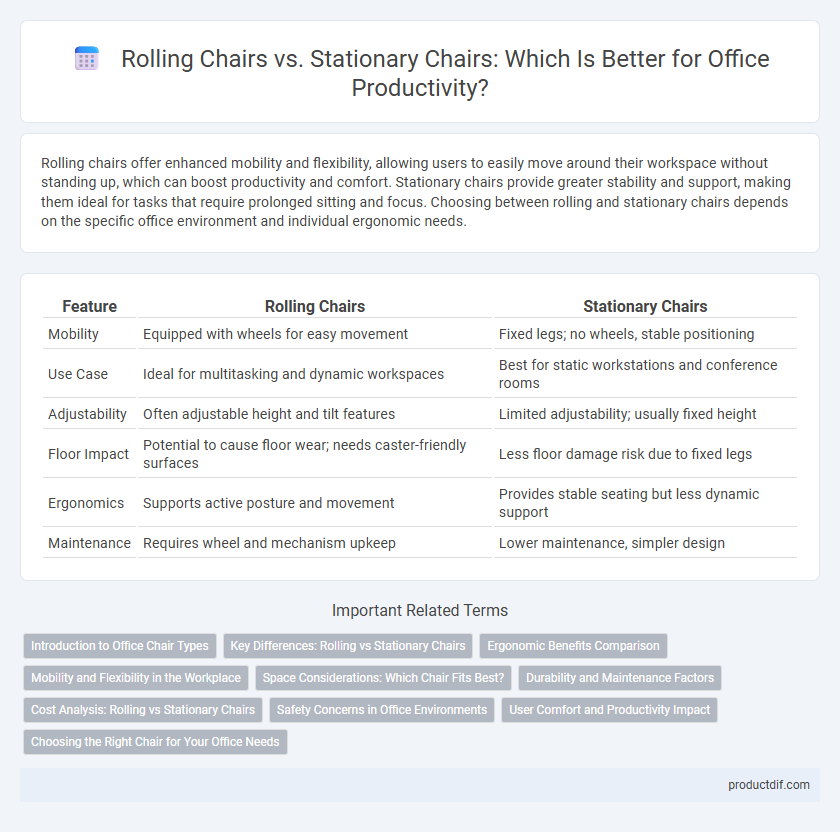Rolling chairs offer enhanced mobility and flexibility, allowing users to easily move around their workspace without standing up, which can boost productivity and comfort. Stationary chairs provide greater stability and support, making them ideal for tasks that require prolonged sitting and focus. Choosing between rolling and stationary chairs depends on the specific office environment and individual ergonomic needs.
Table of Comparison
| Feature | Rolling Chairs | Stationary Chairs |
|---|---|---|
| Mobility | Equipped with wheels for easy movement | Fixed legs; no wheels, stable positioning |
| Use Case | Ideal for multitasking and dynamic workspaces | Best for static workstations and conference rooms |
| Adjustability | Often adjustable height and tilt features | Limited adjustability; usually fixed height |
| Floor Impact | Potential to cause floor wear; needs caster-friendly surfaces | Less floor damage risk due to fixed legs |
| Ergonomics | Supports active posture and movement | Provides stable seating but less dynamic support |
| Maintenance | Requires wheel and mechanism upkeep | Lower maintenance, simpler design |
Introduction to Office Chair Types
Rolling chairs offer enhanced mobility with swivel bases and caster wheels, ideal for dynamic office environments requiring frequent movement. Stationary chairs, featuring fixed legs without wheels, provide stable seating preferred for conference rooms or visitor seating. Choosing between these office chair types depends on workspace functionality and ergonomic needs for posture support.
Key Differences: Rolling vs Stationary Chairs
Rolling chairs offer enhanced mobility and flexibility, allowing users to easily move around their workspace without standing up, which is ideal for dynamic office environments. Stationary chairs provide greater stability and support, often featuring a solid base that minimizes movement and can improve posture over extended periods. Key differences include mobility, with rolling chairs prioritizing ease of motion, while stationary chairs emphasize balance and static comfort.
Ergonomic Benefits Comparison
Rolling chairs enhance mobility and reduce strain by allowing smooth movement across workspaces, promoting better posture and reducing repetitive reaching. Stationary chairs provide stable support with fixed positioning, which can improve focus and maintain consistent ergonomic alignment. Ergonomic benefits favor rolling chairs for dynamic tasks requiring frequent movement, while stationary chairs benefit tasks needing sustained, stationary work.
Mobility and Flexibility in the Workplace
Rolling chairs enhance mobility by allowing users to move effortlessly across the workspace, promoting dynamic interaction and quick access to various office areas. Stationary chairs offer stability and ergonomic support ideal for prolonged tasks but limit flexibility in repositioning. Incorporating rolling chairs in the office setup boosts productivity through adaptable seating arrangements, while stationary chairs provide essential comfort for focused, sustained work.
Space Considerations: Which Chair Fits Best?
Rolling chairs maximize mobility in office spaces, allowing users to easily move between workstations without standing, ideal for larger or multi-functional areas. Stationary chairs, with their fixed bases, offer stability and take up less floor space, making them suitable for compact or minimalist office designs. Assessing room layout and workflow needs helps determine whether the dynamic flexibility of rolling chairs or the space-saving stability of stationary chairs fits best in your office environment.
Durability and Maintenance Factors
Rolling chairs typically feature durable caster wheels designed for smooth movement on various floor types, requiring occasional lubrication and wheel cleaning to maintain functionality. Stationary chairs often have fewer moving parts, resulting in lower maintenance needs but potentially less flexibility and wear resistance in high-traffic office environments. Choosing between rolling and stationary chairs depends on balancing the durability of wheel mechanisms against the simplicity and sturdiness of stationary bases.
Cost Analysis: Rolling vs Stationary Chairs
Rolling chairs typically cost more upfront than stationary chairs due to their added mobility features and adjustable mechanisms, with prices ranging from $100 to $500 compared to $50 to $200 for stationary models. Maintenance costs for rolling chairs can be higher because casters wear out and require replacement, whereas stationary chairs generally incur lower upkeep expenses. When analyzing total cost of ownership, consider productivity benefits from mobility in rolling chairs against the lower initial and maintenance costs of stationary chairs.
Safety Concerns in Office Environments
Rolling chairs offer enhanced mobility but pose increased safety risks like accidental slips or collisions, especially in cluttered office spaces or on uneven surfaces. Stationary chairs minimize these hazards by providing stable seating, reducing the likelihood of falls and work-related injuries. Prioritizing ergonomic design and floor safety can mitigate risks associated with both chair types in office environments.
User Comfort and Productivity Impact
Rolling chairs enhance user comfort by offering mobility and adjustable features that reduce strain during extended work periods, directly boosting productivity in dynamic office environments. Stationary chairs provide stable seating but may limit movement, potentially causing discomfort and reduced efficiency over time. Choosing rolling chairs often results in better ergonomic support and workflow flexibility, supporting sustained user performance.
Choosing the Right Chair for Your Office Needs
Selecting the right office chair involves assessing the need for mobility and ergonomic support, with rolling chairs offering enhanced maneuverability for dynamic workspaces, while stationary chairs provide stability for focused tasks. Rolling chairs typically feature adjustable heights and swivel capabilities, promoting better posture and reducing strain during extended use. Stationary chairs excel in environments requiring minimal movement, delivering robust back support and a steady seating experience for prolonged concentration.
Rolling Chairs vs Stationary Chairs Infographic

 productdif.com
productdif.com